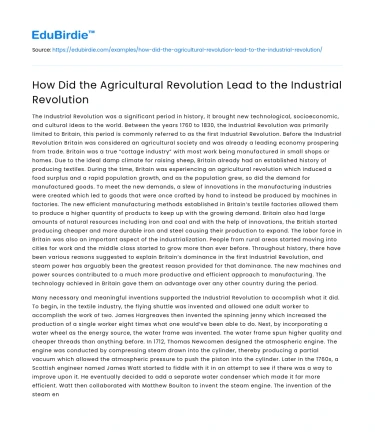The Industrial Revolution was a significant period in history, it brought new technological, socioeconomic, and cultural ideas to the world. Between the years 1760 to 1830, the Industrial Revolution was primarily limited to Britain, this period is commonly referred to as the first Industrial Revolution. Before the Industrial Revolution Britain was considered an agricultural society and was already a leading economy prospering from trade. Britain was a true “cottage industry” with most work being manufactured in small shops or homes. Due to the ideal damp climate for raising sheep, Britain already had an established history of producing textiles. During the time, Britain was experiencing an agricultural revolution which induced a food surplus and a rapid population growth, and as the population grew, so did the demand for manufactured goods. To meet the new demands, a slew of innovations in the manufacturing industries were created which led to goods that were once crafted by hand to instead be produced by machines in factories. The new efficient manufacturing methods established in Britain’s textile factories allowed them to produce a higher quantity of products to keep up with the growing demand. Britain also had large amounts of natural resources including iron and coal and with the help of innovations, the British started producing cheaper and more durable iron and steel causing their production to expand. The labor force in Britain was also an important aspect of the industrialization. People from rural areas started moving into cities for work and the middle class started to grow more than ever before. Throughout history, there have been various reasons suggested to explain Britain’s dominance in the first Industrial Revolution, and steam power has arguably been the greatest reason provided for that dominance. The new machines and power sources contributed to a much more productive and efficient approach to manufacturing. The technology achieved in Britain gave them an advantage over any other country during the period.
Many necessary and meaningful inventions supported the Industrial Revolution to accomplish what it did. To begin, in the textile industry, the flying shuttle was invented and allowed one adult worker to accomplish the work of two. James Hargreaves then invented the spinning jenny which increased the production of a single worker eight times what one would’ve been able to do. Next, by incorporating a water wheel as the energy source, the water frame was invented. The water frame spun higher quality and cheaper threads than anything before. In 1712, Thomas Newcomen designed the atmospheric engine. The engine was conducted by compressing steam drawn into the cylinder, thereby producing a partial vacuum which allowed the atmospheric pressure to push the piston into the cylinder. Later in the 1760s, a Scottish engineer named James Watt started to fiddle with it in an attempt to see if there was a way to improve upon it. He eventually decided to add a separate water condenser which made it far more efficient. Watt then collaborated with Matthew Boulton to invent the steam engine. The invention of the steam engine granted steam power the ability to spread across a multitude of different British Industries. There were also advances in communication. The new velocity of trains led to an urgency for a resourceful method of communication, so William Cooke and Charles Wheatstone invented the first patented telegraphy system which was used for railroad signaling.
Save your time!
We can take care of your essay
- Proper editing and formatting
- Free revision, title page, and bibliography
- Flexible prices and money-back guarantee
Many technological, socioeconomic, and cultural changes occurred during the Industrial Revolution. Britain experienced rapid urbanization in their cities because of severe unemployment and rising poverty in their rural areas. This change resulted in some difficult challenges. Many roads were poorly maintained and undeveloped. Cities started to become overcrowded with some homes being shared by as many as twenty people. In the 1840s, Britain became the first country to have more than half of its population living in urban areas. Steam engines also improved rapidly and were employed in coal mines, textile mills, and numerous other industries. Mine owners began financing a new network of canals to channel their mines more efficiently. By 1815, over two thousand miles of canals were constructed and being used for transporting goods. The canals were highly beneficial and by 1860, twenty percent of all industrial goods in the world were manufactured in Britain. Half of the world’s iron and cotton textiles came from Britain.
The Industrial Revolution may have brought a lot of valuable changes, however, it came at a cost. The mechanization of labor made working in factories a dull and often dangerous task. Factory owners would serve harsh punishments to workers as a sign of discipline. Some factories have been compared to prisons or barracks. Many workers would be forced to work long hours for subsistence wages. Working 12 hours a day was not an uncommon occurrence and accidents with the machinery would also frequently transpire. Because of their size, factories would employ children sent from workhouses or orphanages. The children were used to maneuver between narrow spaces in the fast-moving machinery. Due to the miserable conditions brought on by working in factories, a group known as the “Luddites” was formed. The Luddites were British weavers and textile workers known for their violent resistance to changes in the textile industry of Britain. The Luddites would destroy machinery they believed would threaten their jobs. In an attempt to keep this from continuing to happen, the British government then chose to declare machine-breaking punishable by death.






 Stuck on your essay?
Stuck on your essay?

